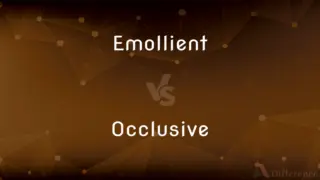Possessive Pronoun vs. Possessive Adjective — What's the Difference?
By Tayyaba Rehman — Published on October 24, 2023
Possessive Pronouns replace nouns to indicate ownership (e.g., mine, yours), while Possessive Adjectives modify nouns to show possession (e.g., my, your).

Difference Between Possessive Pronoun and Possessive Adjective
Table of Contents
ADVERTISEMENT
Key Differences
Possessive Pronouns and Possessive Adjectives are both used to indicate possession in English. However, they serve different grammatical purposes. Possessive Pronouns stand alone and replace the noun, suggesting who the owner of something is. In contrast, Possessive Adjectives come before nouns and modify or qualify them, denoting ownership.
The use of a Possessive Pronoun is evident when one wishes to avoid repetition of a noun previously mentioned. For instance, instead of saying, "That is Sarah's book, not Jessica's book," one could use Possessive Pronouns to state, "That is Sarah's book, not Jessica's." Conversely, Possessive Adjectives are utilized to provide more information about a noun without necessarily replacing it. For instance, "That is my book."
It's vital to understand the distinctions between Possessive Pronouns and Possessive Adjectives to ensure clarity and coherence in speech and writing. For example, saying "This is her" would be incorrect, as "her" is a Possessive Adjective and requires a noun to follow. The correct usage would be, "This is hers," employing the Possessive Pronoun.
In a practical application, when someone asks, "Whose coat is this?" a response might use a Possessive Adjective like, "That's her coat." Alternatively, using a Possessive Pronoun, the answer could be, "It's hers." Both expressions convey the idea of ownership, but the structural context in which they are used differs.
In summary, while both Possessive Pronouns and Possessive Adjectives denote ownership or association, the former replaces nouns, and the latter qualifies them. Recognizing this distinction aids in achieving grammatical accuracy and clarity in communication.
ADVERTISEMENT
Comparison Chart
Function
Replaces nouns.
Modifies nouns.
Examples
Mine, yours, his, hers, its, ours, theirs
My, your, his, her, its, our, their
Position in a Sentence
Stands alone.
Precedes a noun.
Usage
"The book is mine."
"That is my book."
Purpose
Avoid repetition of nouns.
Provide more information about a noun without replacing it.
Compare with Definitions
Possessive Pronoun
A pronoun that indicates ownership and replaces a noun.
The car is mine.
Possessive Adjective
Modifies a noun by indicating who it belongs to.
This is my coat.
Possessive Pronoun
Stands alone in a sentence to show possession.
These cookies are yours.
Possessive Adjective
Precedes and qualifies a noun in terms of ownership.
They took their dog to the park.
Possessive Pronoun
Used to avoid redundancy in speech and writing.
That's Sarah's jacket, not hers.
Possessive Adjective
Describes which noun (or nouns) in particular is being discussed.
They didn't bring their tickets.
Possessive Pronoun
Directly conveys who something belongs to without needing a noun.
These thoughts are uniquely mine.
Possessive Adjective
Works in tandem with a noun to give context about possession.
We sold our old house.
Possessive Pronoun
Highlights the owner of an item without naming the item.
That seat is his.
Possessive Adjective
Provides clarity about the possessor of an item.
She forgot her keys.
Common Curiosities
Can I use a Possessive Adjective without a following noun?
No, a Possessive Adjective requires a noun to follow.
How do I choose between a Possessive Pronoun and a Possessive Adjective?
Use a Possessive Pronoun to replace a noun and a Possessive Adjective to modify a noun.
Which one, Possessive Pronoun or Possessive Adjective, is used to avoid repetition?
Possessive Pronouns are used to avoid repeating nouns.
Where do Possessive Adjectives typically appear in a sentence?
Possessive Adjectives typically appear before the noun they modify.
Can you give an example using a Possessive Adjective?
An example using a Possessive Adjective is "her" in "her book."
Are "its" in "its color" and "its" in "The dog wagged its tail" the same?
No, the first is a Possessive Adjective and the second is a Possessive Pronoun.
What do Possessive Pronouns replace in a sentence?
Possessive Pronouns replace nouns to indicate ownership.
Can you provide an example of a Possessive Pronoun?
An example of a Possessive Pronoun is "hers" in "The book is hers."
What's the Possessive Adjective form of "they"?
The Possessive Adjective form of "they" is "their."
What's the Possessive Pronoun form of "you"?
The Possessive Pronoun form of "you" is "yours."
Do all personal pronouns have Possessive Pronoun and Possessive Adjective forms?
Yes, all personal pronouns have both Possessive Pronoun and Possessive Adjective forms.
How do Possessive Pronouns enhance clarity in writing?
Possessive Pronouns can eliminate redundancy by replacing nouns already mentioned.
In the sentence "The car is mine," which word is the Possessive Pronoun?
In the sentence, "mine" is the Possessive Pronoun.
Why is it important to distinguish between Possessive Pronouns and Possessive Adjectives?
Distinguishing between Possessive Pronouns and Possessive Adjectives is essential for grammatical accuracy and clear communication.
In the sentence "This is my car," which word is the Possessive Adjective?
In the sentence, "my" is the Possessive Adjective.
Share Your Discovery

Previous Comparison
Domestic Income vs. National Income
Next Comparison
Emollient vs. OcclusiveAuthor Spotlight
Written by
Tayyaba RehmanTayyaba Rehman is a distinguished writer, currently serving as a primary contributor to askdifference.com. As a researcher in semantics and etymology, Tayyaba's passion for the complexity of languages and their distinctions has found a perfect home on the platform. Tayyaba delves into the intricacies of language, distinguishing between commonly confused words and phrases, thereby providing clarity for readers worldwide.












































